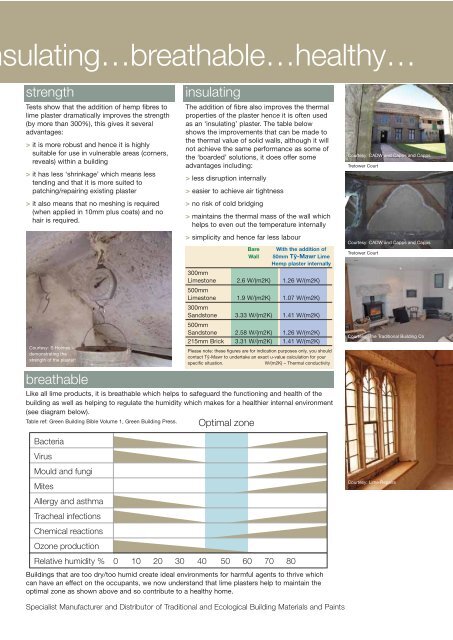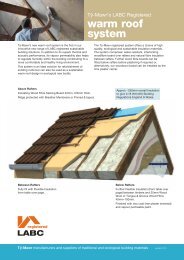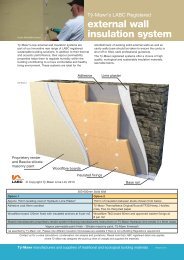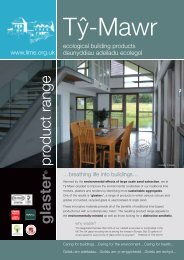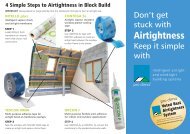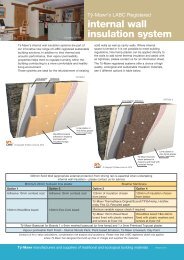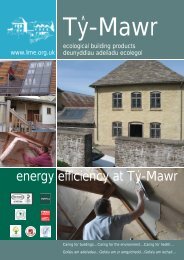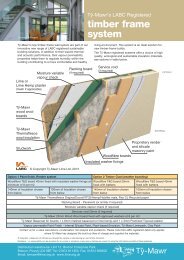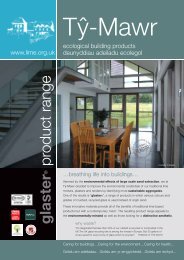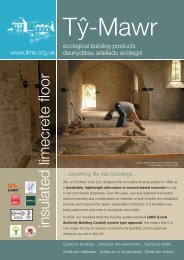lime hemp insulating plaster - Tŷ-Mawr Lime
lime hemp insulating plaster - Tŷ-Mawr Lime
lime hemp insulating plaster - Tŷ-Mawr Lime
- TAGS
- lime
- hemp
- insulating
- plaster
- lime.org.uk
Create successful ePaper yourself
Turn your PDF publications into a flip-book with our unique Google optimized e-Paper software.
sulating…breathable…healthy…<br />
strength<br />
Tests show that the addition of <strong>hemp</strong> fibres to<br />
<strong>lime</strong> <strong>plaster</strong> dramatically improves the strength<br />
(by more than 300%), this gives it several<br />
advantages:<br />
> it is more robust and hence it is highly<br />
suitable for use in vulnerable areas (corners,<br />
reveals) within a building<br />
> it has less ‘shrinkage’ which means less<br />
tending and that it is more suited to<br />
patching/repairing existing <strong>plaster</strong><br />
> it also means that no meshing is required<br />
(when applied in 10mm plus coats) and no<br />
hair is required.<br />
Courtesy: S.Holmes –<br />
demonstrating the<br />
strength of the <strong>plaster</strong>!<br />
breathable<br />
Bacteria<br />
Virus<br />
Mould and fungi<br />
Mites<br />
Allergy and asthma<br />
Tracheal infections<br />
Chemical reactions<br />
Ozone production<br />
<strong>insulating</strong><br />
The addition of fibre also improves the thermal<br />
properties of the <strong>plaster</strong> hence it is often used<br />
as an ‘<strong>insulating</strong>’ <strong>plaster</strong>. The table below<br />
shows the improvements that can be made to<br />
the thermal value of solid walls, although it will<br />
not achieve the same performance as some of<br />
the ‘boarded’ solutions, it does offer some<br />
advantages including:<br />
> less disruption internally<br />
> easier to achieve air tightness<br />
> no risk of cold bridging<br />
> maintains the thermal mass of the wall which<br />
helps to even out the temperature internally<br />
> simplicity and hence far less labour<br />
Optimal zone<br />
Bare With the addition of<br />
Wall 50mm Tˆy-<strong>Mawr</strong> <strong>Lime</strong><br />
Hemp <strong>plaster</strong> internally<br />
300mm<br />
<strong>Lime</strong>stone<br />
500mm<br />
2.6 W/(m2K) 1.26 W/(m2K)<br />
<strong>Lime</strong>stone<br />
300mm<br />
1.9 W/(m2K) 1.07 W/(m2K)<br />
Sandstone<br />
500mm<br />
3.33 W/(m2K) 1.41 W/(m2K)<br />
Sandstone 2.58 W/(m2K) 1.26 W/(m2K)<br />
215mm Brick 3.31 W/(m2K) 1.41 W/(m2K)<br />
Please note: these figures are for indication purposes only, you should<br />
contact T ˆy-<strong>Mawr</strong> to undertake an exact u-value calculation for your<br />
specific situation. W/(m2K) – Thermal conductivity<br />
Like all <strong>lime</strong> products, it is breathable which helps to safeguard the functioning and health of the<br />
building as well as helping to regulate the humidity which makes for a healthier internal environment<br />
(see diagram below).<br />
Table ref: Green Building Bible Volume 1, Green Building Press.<br />
Relative humidity % 0 10 20 30 40 50 60 70 80<br />
Buildings that are too dry/too humid create ideal environments for harmful agents to thrive which<br />
can have an effect on the occupants, we now understand that <strong>lime</strong> <strong>plaster</strong>s help to maintain the<br />
optimal zone as shown above and so contribute to a healthy home.<br />
Specialist Manufacturer and Distributor of Traditional and Ecological Building Materials and Paints<br />
Courtesy: CADW and Capps and Capps<br />
Tretower Court<br />
Courtesy: CADW and Capps and Capps<br />
Tretower Court<br />
Courtesy: The Traditional Building Co<br />
Courtesy: <strong>Lime</strong> Repairs


